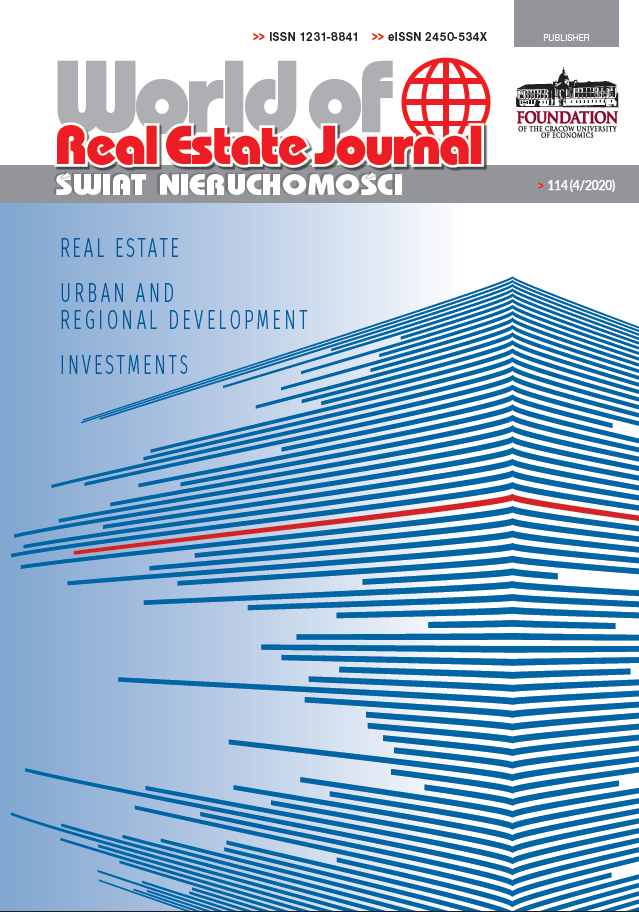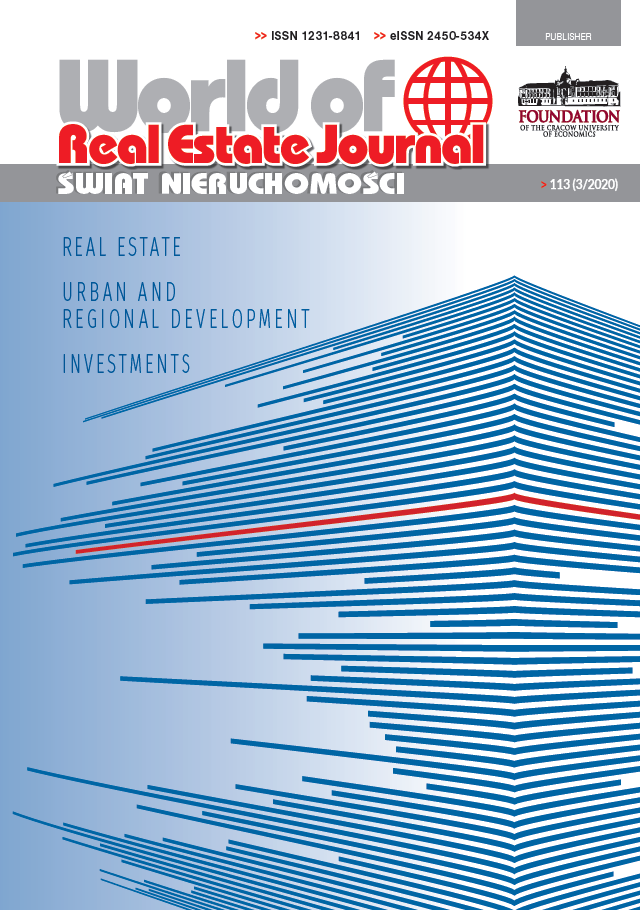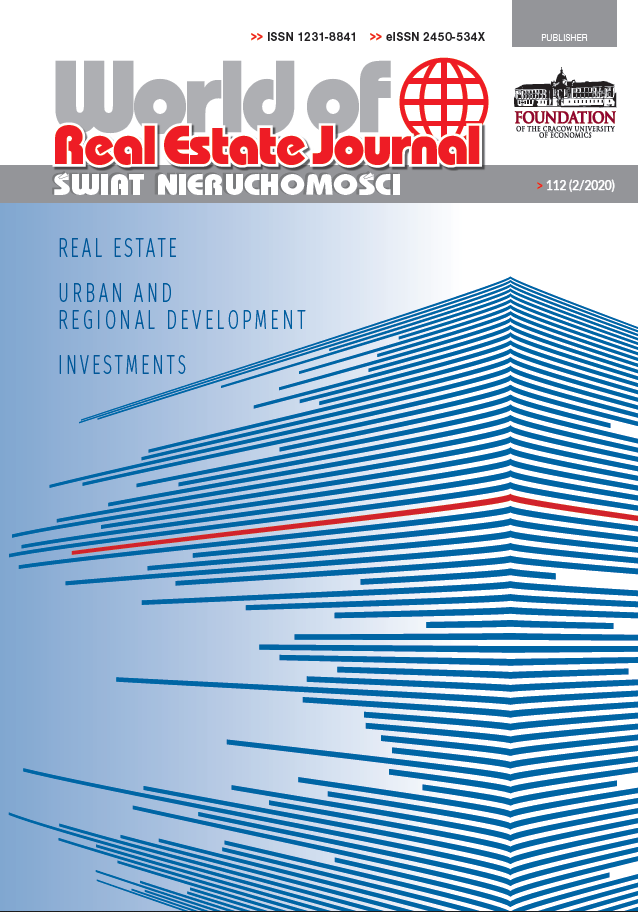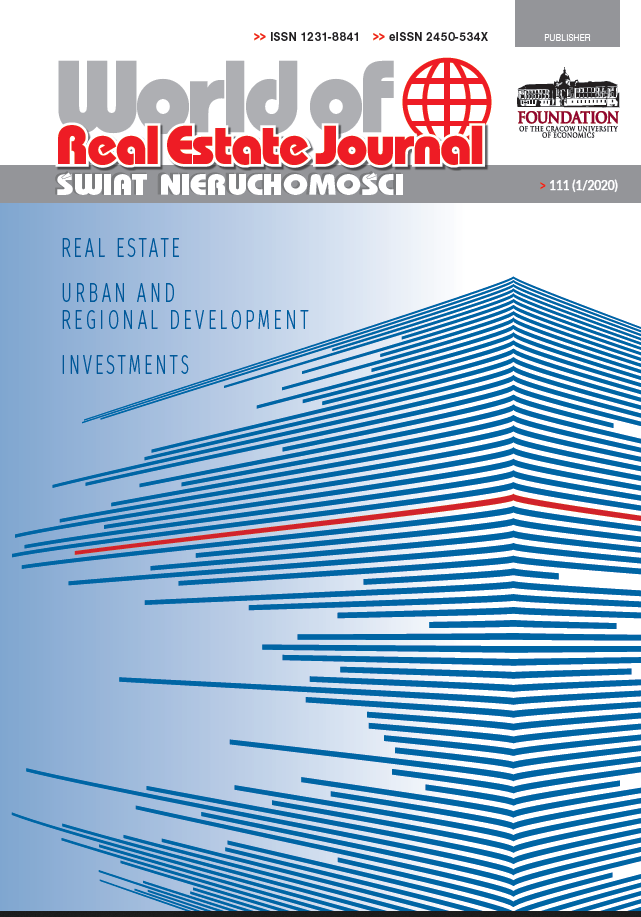REAL ESTATE MANAGEMENT
1) Adam Nalepka, Katarzyna Łach - Inquiring effectiveness of municipal asset management
2) Aneta Zaremba - Market instruments of managing local government’s real estate
3) Natalia Kośnik, Maciej J. Nowak - Perpetual usufruct as an instrument of real estate management in selected municipalities of Szczecin Metropolitan Area
4) Magdalena Małecka-Łyszczek - Duties of property owners according to the Act about maintaining cleanliness and order in municipalities
INVESTMENTS
5) Dariusz Kloskowski - Investment use of floodlands
6) Dariusz Trojanowski, Pawł Kisiel - Price calculation of water supply and sewage networks for the purpose of purchase by supply companies – Net Present Value method
REVITALIZATION
7) Ryszard Frączek, Piotr Musiał - Problems related to investment in historical properties
8) Bogusław Luchter - Influence of urban revitalization on the changes in land use of post-industrial areas (Krakow example)
MARKET
9) Jacek Gołaszewski, Dawid Stolarczyk - Protection of the rights of developer’s client in Poland and in selected European Union countries
HOUSING
10) Iwona Strzepek – Housing conditions in Poland in comparison with European countries
CHANGES IN LAW
11) Maciej J. Nowak - How to update an annual fee for perpetual usfruct DOWNLAND
RESEARCH REPORTS
12) Bartłomiej Marona, Michał Głuszak - The European Portfolio Management Challenge DOWNLAND
SUMMARIES
Adam Nalepka, Katarzyna Łach - Inquiring effectiveness of municipal asset management
Polish municipalities have a considerable volume and range of different properties. Unfortunately, quite often municipal real estate management is fragmented and far from being rational and efficient. The main objective of this paper is to present some possibilities of improving the efficiency and reduce the costs associated with asset management in Polish gminas.
Aneta Zaremba - Market instruments of managing local government’s real estate
Marketing in a municipality’s real estate economy is mainly based on rational municipal real estate management and activation by local real estate market in order to attract investors. The attractiveness of local real estate resources depends on their method of use, legal status, ownership structure and specific type. Local authorities have instruments of community planning, economic, financial, legal and administrative means by which the changes of status, structure and use of land may affected. Developing a marketing strategy in the field of municipal real estate requires the determination of the future economic structure of the community, identify areas for development of selected features and the ability to use and management of municipal property.
Natalia Kośnik, Maciej J. Nowak - Perpetual usufruct as an instrument of real estate management in selected municipalities of Szczecin Metropolitan Area
The aim of this article is to determine the formula and role of perpetual usufruct in Szczecin Metropolitan Area municipalities. The municipalities immediately bordering with Szczecin (included in the Szczecin Metropolitan Area): rural-urban municipality of Goleniów, rural-urban municipality of Police and rural border municipality of Dobra Szczecinska were all under a detailed study. The analysis was made for the years 2007-2010, specifying the underlying the direction in which the municipal authorities granted the perpetual usufruct right, the extent of the land on lease and its purpose. As a partial objective of the article both a data analysis and statistical research were carried out.
Magdalena Małecka-Łyszczak - Duties of property owners according to the Act about maintaining cleanliness and order in municipalities
One of the essential matters covered by the 13th September 1996 Act about maintain cleanliness and order in municipalities is the problem of duties which a legislator laid, in this respect, upon property owners. Having its theoretical as well as practical meaning in mind, it will be elaborated on within the framework of this article. The publication was constructed in a manner including changes which have been in effect since the 1st January 2012 and applied, within the analysed scope, regulations of the communal law as well.
Dariusz Kloskowski - Investment use of floodlands
The article “Investment Use of Floodlands” introduces the topic of legislative deliberations on a possibility of managing wetlands and marshy urban grounds. On the basis of the presented example, which depicts the developing of boggy land of Słupsk, this present study showed the significance of human inclinations in terms of construction on wetlands. At the same time, given a chance to arouse a discussion on the problem which has never been touched before, the author made a preliminary analysis of the monitored investments. In this analysis, which constitutes a determinant in terms of specifying endogenic function of investment risk, a numerical model was used.
Dariusz Trojanowski, Paweł Kisiel - Price calculation of water supply and sewage networks for the purpose of purchase by supply companies – Net Present Value method
Under the conditions of the Polish economic life municipalities tend to, more and more often, transfer the operational management of water supply and sewage networks to companies specially created with that goal in mind. A company performing tasks which have a public utility character has, on the one hand, a typical owner, i.e. the municipality (territorial self-government units such as municipalities should naturally operate as non-profit entities), but, on the other hand, it is a business entity which should operate in a market environment and its management team should make profit-oriented rational and economically justified decisions. The paper is an attempt to indicate the ways of calculating the price which may be applied by utility supplying companies to appropriately set the sales value of water supply and sewage networks built by a “private” investor. Two methods are considered based on the method of discounting cash flows. In the first paper of the series, the authors describe the specific character of the goods offered for sale – that is the water supply and sewage network - and focus their attention on the use of the Net Present Value method for the calculation of the sales price of the network.
Ryszard Frączek, Piotr Musiał - Problems related to investment in historical properties
The article is an elaboration related to problems of pricing and marketing of a particular kind of real estate, which is properties listed in a register of monuments. The authors characterize shortly what a listed estate, specificity of such estate, sources of useful information about the estate. However, when indicating principles of pricing and an outline of the applied methodology in the process of pricing they intend to drawn attention to the fact, that as early as during pricing a potential purchaser or investor may become aware of possible problems which they will meet when they become its owner.
Bogusław Luchter - Influence of urban revitalization on the changes in land use of post-industrial areas (Krakow example)
The purpose of his paper is to evaluate changes in land use in consequence of introducing rules of free market economy. Krakow was selected as the object of research because industrial production was the predominant economic activity during the socialist times and industrial land had the largest share in the developed land. The research concentrated on the urban block (spatial unit limited by streets or other clear distinction lines), located over 1 kilometer from The Main Market – and one of 26 selected in 1980s industrial and warehouse areas of Krakow. The author used the data collected by himself during site surveys: one in 1983 while preparing his doctoral thesis and the second in 2011 carried out for the purpose of this paper. The surveys allowed for an analysis of the land use changes in the time span of 30 years. As a result of the conducted research, fundamental changes in the structure of land use in the selected urban block were observed. Extensively used, the industrial land was replaced by land used for services such as: administration, shopping, recreation or high standard residential developments. Communication areas gained in significance – mainly private transportation and also an increased share of recreational green areas. The functionality of the areas where such changes and developments are observed begin to resemble theoretical models of sustainable urban areas.
Jacek Gołaszewski, Dawid Stolarczyk - Protection of the rights of developer’s client in Poland and in selected European Union countries
Developing activity requires continuous adaptation to the changing legal requirements. The article presents a security system of client interests in the development market in Poland and in the selected European Union countries. The article describes both positive and negative solutions regarding legal regulations.
Iwona Strzępek - Housing conditions in Poland in comparison with European countries
In the paper, housing conditions in Poland compared with European countries were presented and analyzed. The research includes all the European Union countries plus Iceland, Norway and Switzerland. The examined measures of housing conditions are: overcrowding rate, average number of rooms per person, severe housing deprivation, housing cost overburden rate and share of total population living in a dwelling with different housing problems.





















































